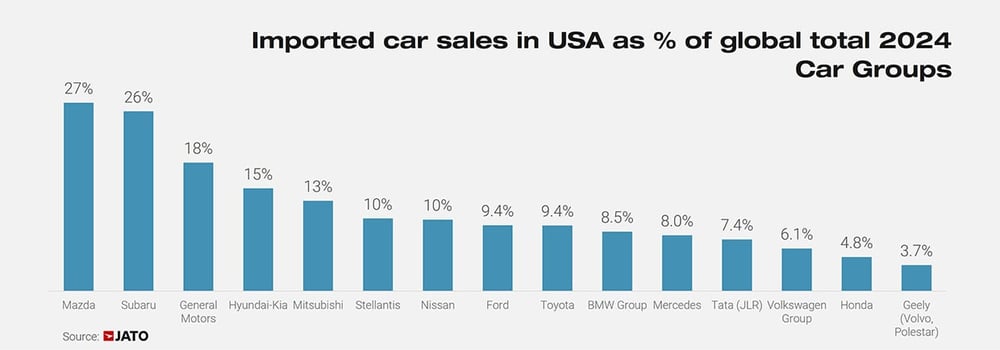LTL stocks bloodied post-Liberation Day, estimates cut ahead of Q1 reports
Less-than-truckload stocks bore the brunt of Liberation Day tariffs, falling 18% on average following the announcement and adding to an already down year. The post LTL stocks bloodied post-Liberation Day, estimates cut ahead of Q1 reports appeared first on FreightWaves.

Transportation stocks took it on the chin following the Trump administration’s announcement of widespread tariffs after the market closed on Wednesday. Less-than-truckload stocks fared the worst in the two trading sessions following Liberation Day as investors who entered the year hopeful for a positive inflection in the industrial complex appear to have called it quits for the time being.
Less-than-truckload stocks fell 18% over the two-day period and are off 33% year-to-date (both on an unweighted basis). (Old Dominion Freight Line’s (NASDAQ: ODFL) outperformance compared to the rest of the group has minimized the impact to the weighted average as it represents 60% of the group’s market cap.)
The LTLs are among the worst performing industrials this year as earnings expectations and valuation multiples are being reset lower.

The sector was a pandemic and post-pandemic darling, garnering record valuations at times, given its manufacturing-heavy exposure and role in a mass inventory restocking. However, an extended industrial downturn along with several carriers acquiring terminals from defunct Yellow Corp. (OTC: YELLQ) in addition to other organic additions, has left many LTL networks at or near record latent capacity. That has LTL bears calling for an unraveling of the industry’s favorable pricing dynamics.
Further, a March report saying Amazon (NASDAQ: AMZN) could become a more meaningful LTL player has weighed on shares.
The first-quarter LTL earnings season, which starts Apr. 23 when Old Dominion reports, may leave onlookers with more questions than answers as an all-out trade war now overhangs an already demand-depressed LTL industry.
Q1 updates showed soft demand trend continued, EPS estimates come down
Intraquarter updates in early March provided no reprieve from the dour volume trends other than to show that a weather-marred January likely marked the worst of the tonnage declines (on a two-year-stacked comparison). Channel checks signaling continued uncertainty around trade policy, which is weighing on capital investment and domestic manufacturing, has prompted analysts to further lower numbers.
Susquehanna Financial Group’s Bascome Majors told clients last week that “the chaotic policy and macro backdrop of the last six weeks has only amplified our fears into this important spring and early-summer period for the industry.”
He lowered first-quarter earnings-per-share estimates for core LTL carriers by 2% to 7%. Full-year 2025 numbers were lowered by high-single-digit to midteen percentages with the changes resulting in flow-through impacts of mid- to highteen percentages to 2026 EPS estimates. His estimates are approximately 10% to 20% below consensus for 2025, and 5% to 20% below 2026 consensus.

FedEx’s (NYSE: FDX) LTL unit, FedEx Freight, also provided lackluster results for its fiscal quarter ended Feb. 28. Revenue was off 5.3% year over year as tonnage fell 7.6% and revenue per hundredweight, or yield, increased just 2.2%. The segment recorded an 87.5% operating ratio (inverse of operating margin), 300 basis points worse y/y.
Roughly 90% of its top line is tied to business-to-business commerce and more tethered to the impact of tariffs. The bright spot, however, was that volume erosion at the nation’s largest LTL carrier appears to have bottomed during its fiscal second quarter ended Nov. 30. when tonnage was down 11.3% y/y (the two-year-stacked comp bottomed in the quarter ended May 31, 2024).
FedEx said the y/y decline in revenue for its current fiscal quarter (ended May 31) is expected to be less severe.
PMI data slides further in all-important March, other headwinds
The Manufacturing Purchasing Managers’ Index signaled slight growth (a reading above 50) for the first two months of the year after a 26-month downturn. However, trends slowed in February as the trade landscape began to shift and March’s 49 reading has the dataset back into contraction territory. Importantly, the new orders subindex came in at 45.2 (after readings of 55.1 and 48.6 in January and February, respectively), a less-than-encouraging signal for near-term demand.
The Tuesday report called out new tariffs and uncertainty around future tariffs as the primary detractors.
The prices subindex jumped again, up 7 percentage points from February to 69.4, as many industries are already seeing the inflationary impact from the new levies. (Changes in PMI data usually precede LTL volume inflections by three to four months. Industrial-related shipments account for roughly two-thirds of freight mix for some carriers.)
Other analyst reports said recent conversations with industry participants combined with other data points indicate demand headwinds didn’t abate in March – the seasonally strongest month of the first quarter. The LTL industry has lost some heavier-weighted shipments to the truckload market as rates in that market largely remain depressed. The LTL space won’t likely recover that freight until there is a material inflection in the TL spot market.
Also, lower fuel surcharge revenue (diesel prices were down 9% y/y in the quarter) is weighing on yields, which remain positive excluding fuel. Fuel recovery mechanisms for LTL carriers are significantly accretive to margins when prices at the pump rise.
Carriers have been successful capturing annual contractual rate increases in the mid-single-digit range, but after multiple quarters of gains, the redeployment of numerous terminals that need to generate returns sooner than later, and a still-soft demand backdrop, it will be interesting to see how the industry’s “price discipline” mantra holds throughout the year.
“We remain firm in our belief that LTL earnings risk is far more about volume than pricing risk (more analogous to rail than truckload) as we continue to believe pricing discipline will still hold through a further extended period of demand weakness and excess capacity,” Majors said.

TFI’s LTL unit needs an overhaul
TD Cowen cut estimates on Montreal-based TL, LTL and logistics conglomerate TFI International (NYSE: TFII), citing margin risk at LTL subsidiary TForce Freight, among other concerns. On a consolidated basis, TFI’s businesses are roughly 80% exposed to the industrial complex and feeling the pressure from tariffs, analyst Jason Seidel said in a March 28 note. That exposure extends to its specialized TL segment, which includes the acquisition of flatbed carrier Daseke.
Seidel cut his first-quarter estimate by 9% and the 2025 full-year number by 3% (both of which were below consensus at the time). The 2026 estimate was trimmed 5% and remains above consensus. He also cautioned that the company’s full-year LTL OR target of 93% to 95% could be in jeopardy. He is forecasting a 99% OR in the unit during the first quarter.
TFI chief Alain Bédard candidly told investors on a February fourth-quarter call that its U.S. LTL platform lacked volume density and was effectively broken. He pointed to a negative flywheel of poor service leading to soft volumes (poor density) leading to poor pricing, and outlined several cost and service-enhancement initiatives around maintenance, linehaul, routing and billing.
Bédard also said TFI was unlikely to engage in any “large M&A” during the year, implying that its timeline to acquire a large U.S. LTL carrier as early as late-2025 has been extended.
Majors cut his TFI estimates by 12%, 19% and 13% for the first quarter, full-year 2025 and full-year 2026, respectively.
TFI is the second-worst performing stock in trucking this year (down 41%) given its LTL woes. Forward Air (NASDAQ: FWRD) is the worst performing stock (down 59%) as investors await the results of a strategic review following a controversial merger with Omni Logistics.
Shares of the also industrial-dependent U.S. Class I railroads were off 10% on average in the two sessions following Liberation Day.
The severity of the pullback in transports may have investors returning sooner than later, especially given the administration’s on-again, off-again approach with prior tariffs.
More FreightWaves articles by Todd Maiden:
- Turvo, SMC3 team up to improve LTL shipping process
- March supply chain data craters following inventory pull-forward
- Yellow’s new bankruptcy plan revealed, next steps still uncertain
The post LTL stocks bloodied post-Liberation Day, estimates cut ahead of Q1 reports appeared first on FreightWaves.































































































![F/A-XX hints, icebreaker ambitions and previewing day two of Sea Air Space [VIDEO]](https://breakingdefense.com/wp-content/uploads/sites/3/2025/04/250407_SAS_2025_indopac_WELCH-scaled-e1744076170241.jpg?#)
























































































